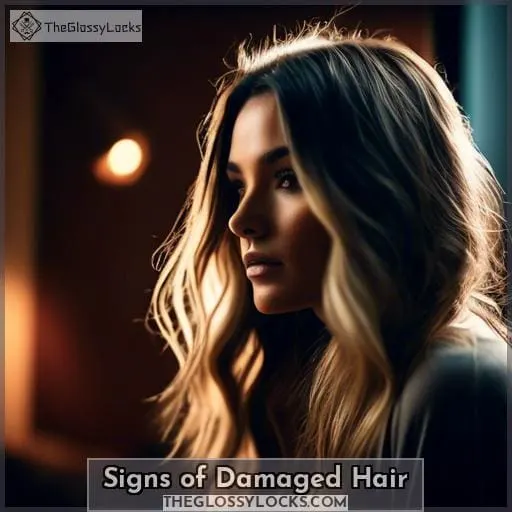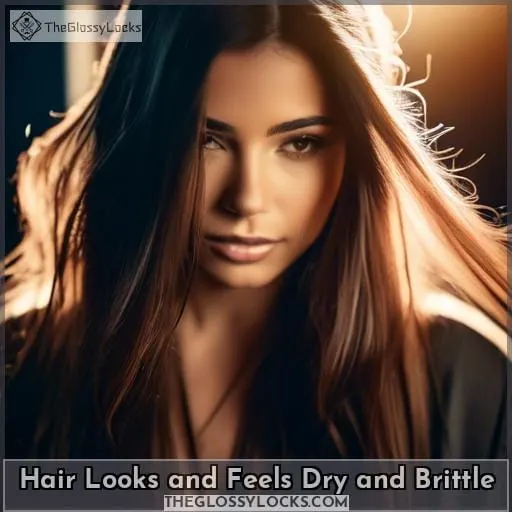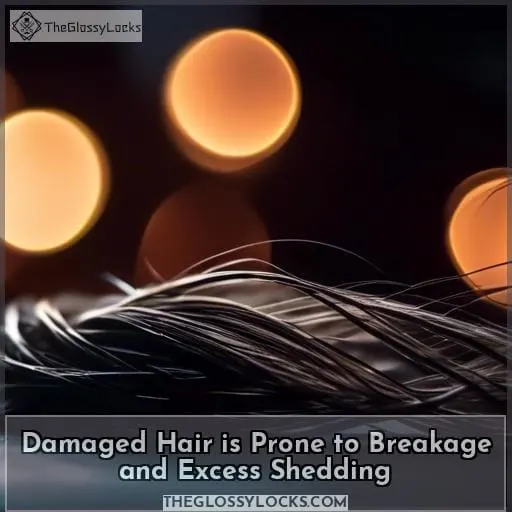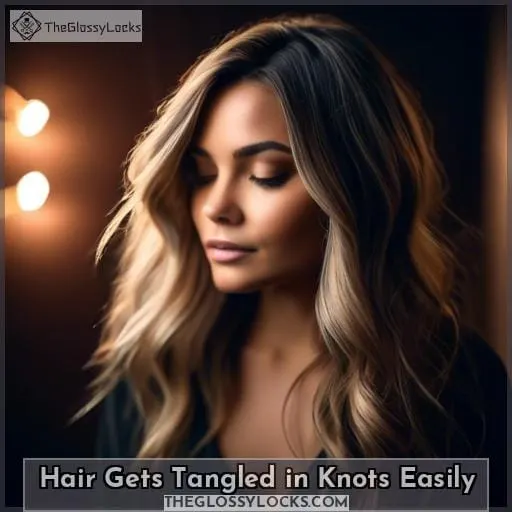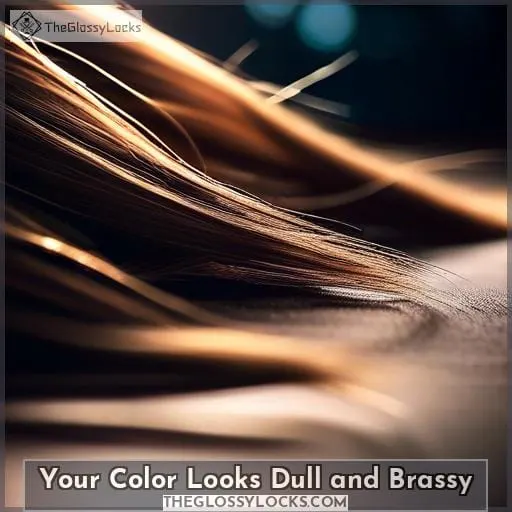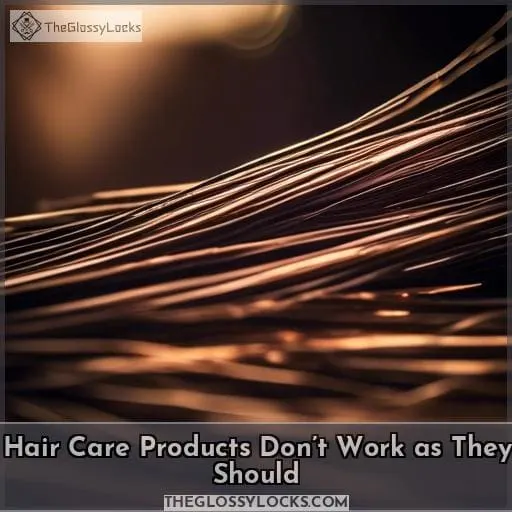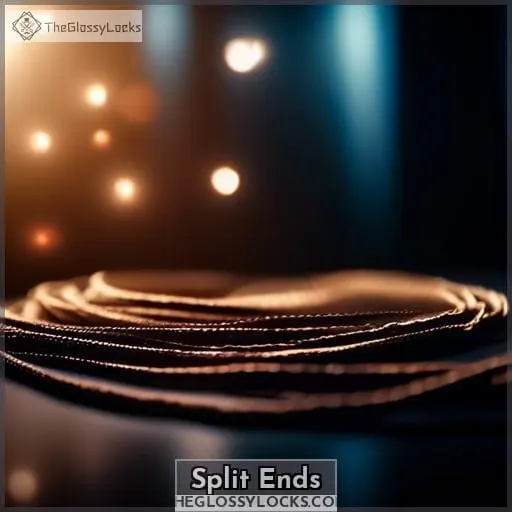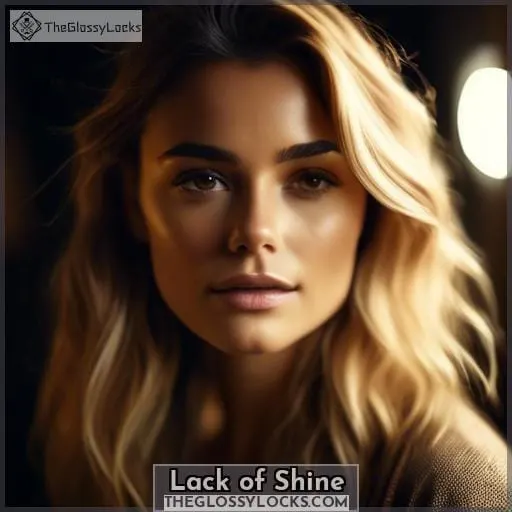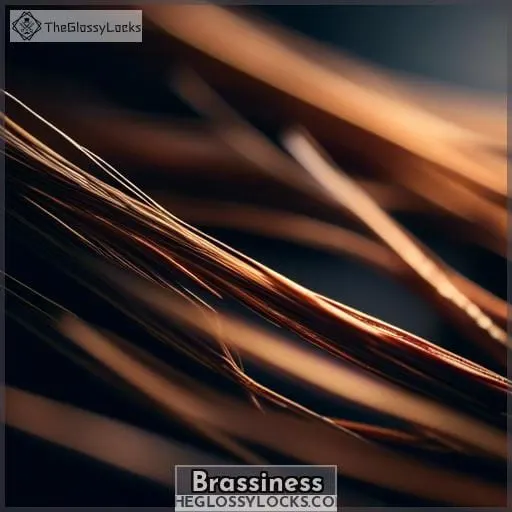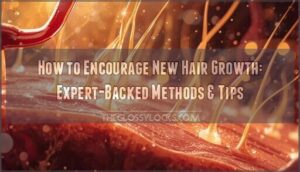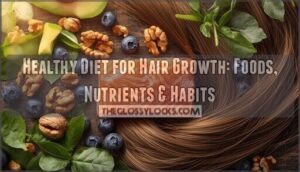This site is supported by our readers. We may earn a commission, at no cost to you, if you purchase through links.
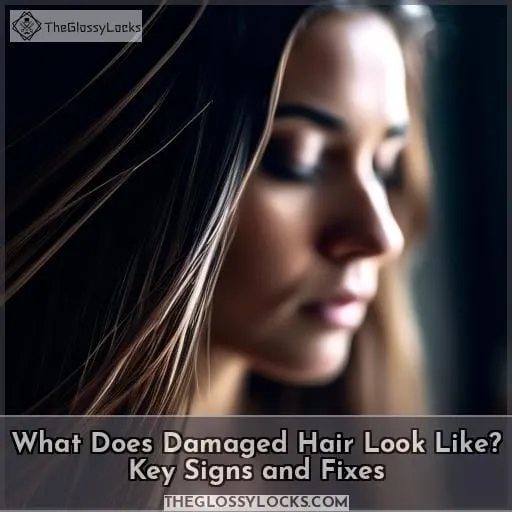
These signs indicate that your hair needs immediate attention and care. Understanding the key signs of damaged hair is the first step to restoring its vitality and preventing further harm.
Let’s delve into what damaged hair looks like and how you can fix it.
Table Of Contents
- Key Takeaways
- What Does Damaged Hair Look Like
- Signs of Damaged Hair
- Hair Looks and Feels Dry and Brittle
- Damaged Hair is Prone to Breakage and Excess Shedding
- Hair Gets Tangled in Knots Easily
- Your Color Looks Dull and Brassy
- Hair Care Products Don’t Work as They Should
- Split Ends
- Lack of Shine
- Brassiness
- Dryness
- Frequently Asked Questions (FAQs)
- Conclusion
Key Takeaways
- Damaged hair often appears dry and brittle, lacking natural shine and feeling parched, which can lead to breakage, split ends, and dullness.
- Hair that is damaged may become tangled easily, forming knots and mats, and may appear dull and frizzy due to high porosity.
- Signs of damage also include hair that has lost its elasticity, resulting in hair that lacks bounce and does not hold styles well.
- Chemical treatments and environmental factors can lead to hair that is over-processed, with faded color, brassiness, and a reduced effectiveness of hair care products.
What Does Damaged Hair Look Like
Damaged hair typically looks dull, dry, and brittle, with split ends and a tendency to break easily.
Signs of Damaged Hair
Damaged hair can be a real downer, can’t it? It’s like your once vibrant locks have turned into a lifeless straw pile. If you’re noticing your hair has lost its pep, it might be waving a white flag for help.
First off, porous hair is like a sponge that’s seen better days—too eager to soak up moisture and just as quick to let it go, leaving you with a frizzy mess. Then there’s over-processed hair, which has been through the wringer with dyes and treatments, and it’s got the battle scars to show for it.
Elasticity loss? It’s when your hair has as much bounce as a week-old lettuce leaf.
Sun exposure isn’t just a beach day souvenir; it can leave your hair as parched as a desert. And chemical burns from harsh treatments? They’re like a bad date with your hair—unforgettable for all the wrong reasons.
If you’re spotting split ends more often than you find loose change in the couch, or if your hair’s dryness could rival a cactus, you’re in the damage zone. But don’t fret! With some TLC and a break from the heat and chemicals, you can nurse your tresses back to health.
Remember, your hair’s not just a fashion statement—it’s a part of you that deserves care and respect.
Hair Looks and Feels Dry and Brittle
Moving from the general signs of damaged hair, let’s zero in on one particularly troubling symptom: when your hair feels as dry and brittle as a tumbleweed in the desert. If your locks have lost their luster and seem more fragile than a house of cards, you’re likely dealing with hair that’s crying out for moisture and care.
Dry and brittle hair can be a real buzzkill, making every day a bad hair day. It’s like your hair has taken on the texture of a brillo pad, and no amount of wishing upon a star seems to bring back that silky smoothness.
This dryness can lead to a dry scalp and an itchy scalp, which only adds insult to injury. And let’s not even talk about the hair loss and thinning hair that can follow—it’s like watching your once glorious mane disappear down the shower drain.
But fear not! Your hair care products can still be your knights in shining armor. With the right hair health strategy, you can combat hair breakage and weak roots. It’s time to show your brittle hair who’s boss and bring back the shine and strength it deserves.
Remember, Rome wasn’t built in a day, and neither is the road to recovery for parched tresses. So arm yourself with conditioner, lay off the heat styling, and prepare to fight the good fight against the dryness dragon.
Damaged Hair is Prone to Breakage and Excess Shedding
When your hair starts to feel like a brittle bundle of straw, it’s waving a white flag. Damaged hair is prone to breakage and excess shedding, and it’s not just a bad hair day—it’s a cry for help.
- Weak strands: Your hair snaps faster than a twig in a toddler’s hands.
- Brittle hair: It’s as if your mane has been sunbathing in the Sahara—without sunscreen.
- Breakage risk: Each brush stroke feels like a gamble, will it stay or will it go?
- Shedding hair: You’re leaving more hair behind than a cat in summer.
- Damaged hair: It’s got more splits than a gymnast at the Olympics.
If you’re nodding along, it’s time to show your locks some love. Cut down on the heat styling, and treat your tresses to a spa day with a deep conditioner or a nourishing oil treatment.
Hair Gets Tangled in Knots Easily
Continuing from the woes of breakage and excess shedding, let’s talk about another tell-tale sign of hair crying out for help: when it gets tangled into knots with ease. If you’re constantly battling with matted hair, it’s like your strands are throwing a tantrum, screaming for attention.
High hair porosity could be the culprit, making your hair more prone to snags and knots.
Imagine your hair as a delicate fabric; when it’s damaged, it’s as if the threads are frayed, catching on each other and causing a ruckus. To smooth things over, incorporating friction reduction techniques into your hair care routine is key.
Think of detangling products as peacekeepers, stepping in to calm the chaos and restore order.
But here’s the kicker: if your hair care routine is more of a hit-and-miss affair, you might as well be inviting tangles to a party. And trust me, they’ll show up—uninvited and overstaying their welcome. So, to keep your hair from crossing into the land of frizz and dullness, it’s time to get strategic.
Use the right tools and techniques to gently persuade those tangles to unwind, and you’ll be on your way to smoother, more manageable locks.
Your Color Looks Dull and Brassy
When you’re battling with hair that’s lost its luster and turned brassy, it’s like watching your favorite silk blouse fade from vibrant to dull. Just as tangled knots followed your hair’s cry for help, color fading, color loss, and a brassy appearance are the next chapters in the saga of hair distress.
If your once radiant hair now looks as lackluster as a cloudy day, you’re witnessing color alteration and a cry for a color change.
Brassy hair can be as stubborn as a stain on your favorite shirt, and it’s often a sign that your hair is shouting for a keratin treatment. This unwanted yellowing or orange hue is like a gatecrasher at a party, turning heads for all the wrong reasons.
But don’t fret, there’s a silver lining. With the right care, you can wave goodbye to brassiness and welcome back the vibrant color you miss.
Hair Care Products Don’t Work as They Should
Transitioning from the woes of dull and brassy hair, let’s dive into another tell-tale sign of hair in distress: when your hair care products just don’t seem to cut it anymore. If you’ve noticed that your once trusty shampoos and conditioners are no longer performing their magic, it might be a red flag that your hair is crying out for help.
When products that used to leave your hair feeling rejuvenated and lively now leave it lackluster, you could be dealing with product buildup, a common culprit that masks your hair’s true condition. This sneaky issue can lead to scalp irritation and even hinder hair growth, as the residue from overzealous product use forms a barrier on your scalp.
Men’s hair, often shorter and styled differently, isn’t immune to these issues either; improper application of products can lead to similar frustrations.
Chemical sensitivity is another factor to consider. If your scalp feels like it’s on fire after your usual hair routine, it’s a sign that something’s amiss. It’s not just about what you’re putting on your hair, but also how much. Overuse of hair care products can lead to a host of problems, including the dreaded frizz and breakage.
So, what’s the fix? First, take a step back and assess your product arsenal. Are you piling on more than your hair can handle? It might be time to embrace the minimalist approach and give your hair a breather.
And remember, the best application is often a gentle one – no need to go to town on your scalp like it owes you money.
In short, if your hair care routine isn’t making the cut, consider it a nudge to reevaluate your products and how you use them.
Split Ends
Continuing from the frustration of ineffective hair care products, let’s tackle the pesky issue of split ends. You know, those tiny hair traitors that betray your quest for sleek, healthy locks.
- Split End Types: You’ve got the classic split, the mini-branch, and the dreaded tree. Each one a tiny testament to your hair’s cry for help.
- Causes of Split Ends: Over-styling, harsh brushing, and just life in general. Your hair’s been through a lot, hasn’t it?
- Split End Treatments: Snip them off, embrace deep conditioning, and consider bond-building therapies.
Lack of Shine
If your hair’s lost its sparkle, you’re not alone. Dull hair can be a real downer, making you feel like you’re sporting a haystack on your head rather than luscious locks. But don’t fret, it’s not the end of the world – or your hair. Lack of shine often points to hair porosity issues, where your hair’s as thirsty as a marathon runner in the desert, soaking up moisture but not retaining it.
This can lead to a cascade of woes, from dandruff to hair loss, and even scalp irritation joining the uninvited party.
But here’s a silver lining: you can turn the tide on dull hair. Start by giving your hair and scalp the TLC they deserve. Think of your hair like a garden; it needs good soil (aka root health) to flourish.
So, ditch those harsh chemicals and embrace nourishing treatments that’ll make your mane the envy of the town.
Brassiness
Brassiness in your hair can be a telltale sign of damage, and it’s a common gripe, especially if you’ve spent a pretty penny on that dreamy hair color. Imagine the horror when your chic ashy blonde starts to look more like a rusty penny! This brassy debacle often stems from hair porosity issues.
If your hair has low porosity, it struggles to soak up and retain moisture, leading to that unwanted brassy hair.
When your hair is overexposed to the sun or you’ve been a bit too enthusiastic with the bleach, the result can be a warm, yellowish tone that screams damage. It’s like your hair is throwing a fit, demanding some TLC. To combat this, you might want to buddy up with color-correcting shampoos.
Purple or blue toning shampoos are like the knights in shining armor for your brassy strands, neutralizing those pesky warm tones.
But let’s not just slap a band-aid on it. Prevention is key! Protect your hair from the sun, and maybe it’s time to give the heat styling a break. And remember, hard water is no friend to your hair color, so consider a filter to keep those minerals from crashing the party.
Keep your hair’s porosity in check, and you’ll be well on your way to saying goodbye to brassiness and hello to vibrant, healthy locks.
Dryness
When your hair feels like straw and looks like it’s been through a desert trek, you’re dealing with dryness. This isn’t just about your strands waving a white flag; it’s a cry for hydration from the depths of each hair follicle.
Imagine your scalp as a garden; without proper moisture, you’re just cultivating a field of hair breakage and hair loss, not to mention the unwelcome dandruff that might show up like uninvited party crashers.
And let’s not forget the scalp irritation that can feel like a tiny cactus party on your head.
But fear not, you can turn the tide on this dry spell. It’s time to quench your hair’s thirst, much like a parched traveler stumbling upon an oasis. Start by showing your scalp some love with a hydrating shampoo, think of it as a soothing balm for that prickly scalp irritation.
Follow up with a conditioner that’s like a tall drink of water for your brittle strands. And remember, over-styling with heat is akin to sunbathing in the Sahara for your hair – so maybe give the blow dryer a break.
Embrace the air-dry, and watch your hair’s vitality bounce back like a well-watered willow.
Frequently Asked Questions (FAQs)
How does hair porosity affect damage repair?
High porosity means your hair’s like a sponge, soaking up moisture but struggling to keep it.
Imagine a leaky bucket; that’s your hair trying to hold onto hydration.
To fix it, think of sealing those leaks with nourishing treatments that fill the gaps and smooth the surface.
It’s a bit like patching up a well-loved, leaky boat so it can sail smoothly again.
Can certain hairstyles contribute to hair damage?
Yes, certain hairstyles can indeed lead to hair damage. Tight ponytails, braids, and buns create tension that can weaken your hair and cause breakage.
It’s like playing tug-of-war with your tresses—eventually, something’s gotta give!
How does hard water impact hair health?
Hard water, loaded with minerals like calcium and magnesium, can wreak havoc on your hair. It leaves your hair as dry as a bone and as dull as a cloudy day. Additionally, hard water can lead to a flaky scalp and make your hair more prone to breakage.
Are there specific vitamins that improve hair damage recovery?
To bolster your hair’s comeback from damage, ensure your diet includes vitamins like biotin, C, D, E, and iron.
They’re like your hair’s personal repair crew, working to patch up those pesky split ends and dullness.
How do hormonal changes influence hair damage?
As the saying goes, You can’t teach an old dog new tricks, but when it comes to your hair, hormones might just have a few lessons up their sleeves.
Hormonal changes can play a significant role in hair damage, affecting everything from texture to volume. For instance, fluctuations in estrogen and progesterone levels can lead to thinner, more brittle hair, while androgens can cause hair to grow in less desirable places or fall out where you want it most.
So, if your locks are looking lackluster, it might be time to check in with your hormones—they could be the root of the problem.
Conclusion
Imagine your hair as a once vibrant tapestry, now dulled and frayed by time and neglect.
Dryness, brittleness, and a lackluster appearance are clear signs that your hair is crying out for help. By recognizing these symptoms, you can take the necessary steps to restore its health and shine.

